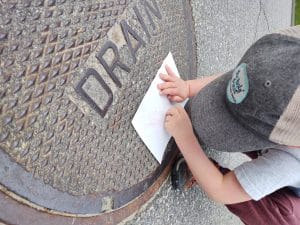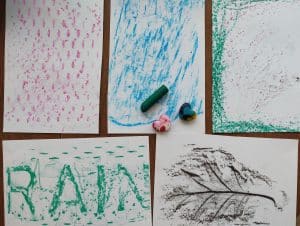
If you’ve ever been in a store, public bathroom, or museum with a young child, you know their urge to touch everything is strong. The good news is that, barring exceptions like poison ivy, nature is full of opportunities for truly hands-on exploration! Touching and manipulating the natural world gives children those authentic experiences they crave while setting the stage for a deeper understanding of and connection with nature.
To explore texture this week, you can play the mystery item guessing game explained in the video below, or read on for some more ideas!
When you are OUTSIDE:
- Bring some paper and unwrapped crayons outside to make rubbings of different textures like tree bark, leaves, and even manhole covers. You could also turn this into a matching game: make rubbings of a selection of five different leaves, then have your child try to match each one to the correct leaf.


- Try going on a moss and lichen hunt! How many different kinds can you find? What do they feel like? Look on tree trunks, stones, fallen branches, and shady sidewalk cracks. Wondering about the difference between moss and lichen? Mosses are plants, so they are generally greener and feel plush and springy. Lichen, which are made up of fungus and algae, often range from greyish green to greenish blue and may form a crust, have a ruffled leafy shape, or even look like hair or tiny branching coral.

- Does your child enjoy going barefoot? Doing so can help them build bodily awareness, develop strong feet, learn to balance, and is of course a great way to literally connect with nature. Take turns leading a barefoot follow-the-leader-style walk that incorporates different textures (moss, mud, mulch, sand, a pan of water, bumpy pebbles, etc.), and compare notes along the way!
To keep exploring texture INSIDE:
- Collect natural items with different textures to use as “nature paintbrushes.” You can dip them directly in the paint, or use a clothespin as a handle for something like a bundle of grass. How does it feel to paint with each one? How do the brushstrokes differ? You can also incorporate your sense of touch with some fingerpainting!
- Try stamping items like leaves or shells into playdough to capture a fossil-like imprint. Use polymer or air-dry clay for a more permanent option.
Sensory play can be fun, engaging, and soothing, even for older children (and adults!). Providing opportunities for this sort of play indoors may be especially important if current restrictions limit your family’s access to outdoor spaces with mud, sand, or water. There are tons of options–try making oobleck, setting up a sensory bin, kneading dough together, or setting up some pouring and water play at the sink.
Our educators, scientists, advocates, and naturalists are committed to keeping you connected to the natural world as we deal with the coronavirus situation together. Check in every weekday on our Connections page for family activities, parent/teacher tips, backyard birding, nature exploration at our sanctuaries, and more.
